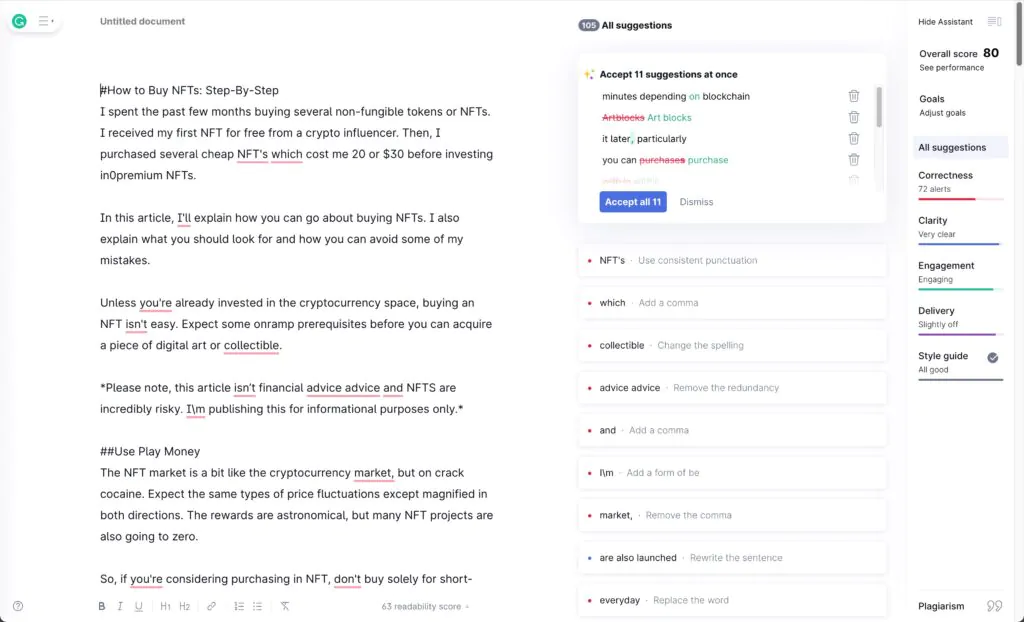Discover our guide that looks at the difference between grammar and punctuation; become a pro at spotting errors, editing text and writing essays!
Mastering the art of grammar and punctuation is what will make your writing stand out in the crowd. Understanding the difference between grammar and punctuation is essential for all writers looking to grow their audience, gain top grades or self-publish their work.
It might sound tricky to wrap your head around, so I’ve created a simple, straightforward, fun guide to help you understand the key differences between these essential writing skills. Whether you’re a newbie writer or a master wordsmith, it’s time to brush up on your grammar and punctuation and get ready to level up your writing skills.
|
5.0
|
4.5
|
|
$30 per month
|
$79 per year
|
Contents
The Role of Grammar

Grammar plays an important role in the English language by providing the framework for how we compose our sentences. It acts as the blueprint that makes sure our sentences and paragraphs fit together perfectly.
Following grammar conventions lets our writing flow smoothly and ensures that readers can understand the content. Without proper grammar, our writing wouldn’t make sense! Imagine if we eliminated commas, apostrophes, periods and semicolons; all of our words would create one long run-on sentence that would be impossible to understand. Grammar is the key to creating impactful and interesting writing that communicates our thoughts and ideas.
What Is Punctuation?

Punctuation refers to the symbols used in sentences to make the meaning even clearer. The period (.) is one of the most commonly understood punctuation marks, but writers have many others they can use.
Here’s a quick refresher of some other common punctuation symbols:
- Periods (.) separate sentences. In British English, these are called full stops.
- Commas (,) separate parts of sentences and indicate a pause, but not a full sentence stop.
- Question marks (?) designate a question and are used in place of a period.
- Exclamation marks (!) indicate stronger emotions when placed at the end of a sentence.
- Quotation marks (“) separate quotes from the rest of the sentence.
- Apostrophes (‘) denotes missing letters in conjunctions as well as possessive words.
- Hyphens (-) join words and create a natural division between syllables when words need to be broken at the end of a line
- Colons (:) introduce lists and long quotes.
- Semicolons (;) can join two sentences to avoid a run-on sentence.
- Ellipses (. . .) show where a writer omits words, phrases or lines in a quoted passage.
- Brackets( () ) or brackets ( [] ) can set apart extra information added to the sentence.
- Dashes (–) separate words in a sentence into a parenthetical statement.
Are Grammar and Punctuation Different?
Grammar and punctuation are both essential for writing effectively. Although they are similar and often confused with one another, they have some key differences. Grammar helps us arrange our words correctly so that our sentences make sense, while punctuation adds marks like commas and periods to show us where to pause or stop. Working together, grammar and punctuation make your writing make sense!
In a research paper or academic writing, punctuation marks help writers use complex sentences and join independent clauses to make a complete sentence without grammar mistakes. Avoid making common grammar mistakes by reading our guide!
How Punctuation Clarifies Meaning
One of the most important roles punctuation fills is protecting the meaning of a sentence. Consider this common example from the popular book Eats, Shoots & Leaves by Lynne Truss: “Let’s eat, grandma!” In this sentence, a grandchild is inviting grandma to eat a meal together. In contrast: “Let’s eat grandma!” has a far more nefarious meaning. In this example, the simple comma makes a tremendous difference in the meaning of the words.
The apostrophe also has an important role in designating meaning. Consider the sentence: “The red glow was the sun’s.” The apostrophe denotes a possessive noun, which means the glow belonged to the sun. In contrast: “The red glow was the suns.” This sentence shows no possessive noun. The reader must assume that they are reading about a different planet where more than one sun shines light on the ground.
Common Punctuation Errors
As you work to improve your writing skills and understand the difference between grammar and punctuation, knowing how to use commas, periods, exclamation points and other punctuation marks is an important step. Here is a quick look at some common punctuation errors and how to avoid them.
1. Run-on or Comma Splice
A run-on sentence occurs when a writer places two independent clauses into one sentence. A comma splice is a type of run-on where the sentences are joined using just a comma without a conjunction. Here are some examples:
- The dog ran after the squirrel, and he almost caught him. (Correct)
- The dog ran after the squirrel; he almost caught him. (Correct)
- The dog ran after the squirrel he almost caught him. (Run-on)
- The dog ran after the squirrel, he almost caught him. (Comma splice)
2. Extra Apostrophes
Apostrophes have two main jobs. They can show possession, and they can show where missing letters are in a contraction. Sometimes, people try to add apostrophes where they aren’t needed, such as in plural words. Here are some examples of correct and incorrect use of the apostrophe:
- He’s going to bring us a present when he comes to visit. (Correct)
- John’s mother waved a sad goodbye to her grandkids before boarding her flight. (Correct)
- Johanna spelled her name with two n’s. (Correct)
- The car was listed for a thousand dollar’s off retail. (Incorrect)
There is no need for an apostrophe in the last example because the “s” is being used to denote the plural. An apostrophe is only needed for a plural word when the writer makes a plural from a single letter.
3. Extra Commas
Most writers focus on making sure not to use too few commas, but it’s also common for writers to use too many. Here is a correctly written sentence: “I wanted to grab a bite to eat because I was hungry, but the restaurants were closed, so I just went home.”
Sometimes, writers will write this with two extra commas, like this: “I wanted to grab a bite to eat, because I was hungry, but the restaurants were closed, so I just went home.” In this sentence, because does not require a comma because it is a subordinating conjunction. “So” does require one because it is a coordinating conjunction, and the two independent clauses need to be joined with a comma and conjunction as well.
4. Improper Quotation Mark Placement
Quotes are a common area for punctuation mistakes. Remember that the punctuation goes inside the quotation mark. If the thought is not complete, then the quote closes with a comma. If the thought is complete, it ends with an end punctuation mark, like a period or exclamation point. Let’s look at an example:
- “Wow”, said Mark. “That quarterback threw a huge pass”! (Incorrect)
- “Wow,” said Mark. “That quarterback threw a huge pass!” (Correct)
Looking for more? Check out our round-up of the best grammar checkers!

